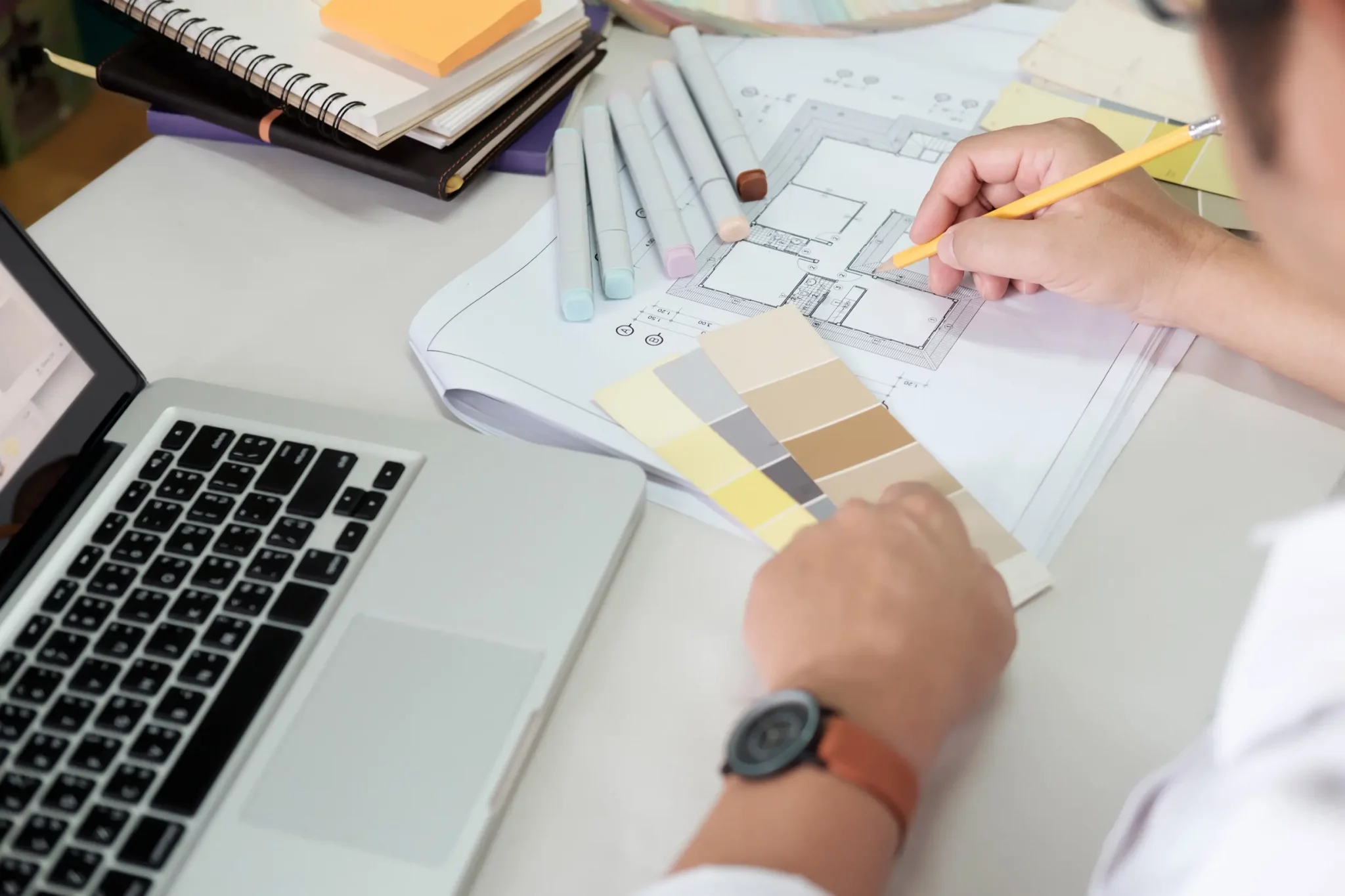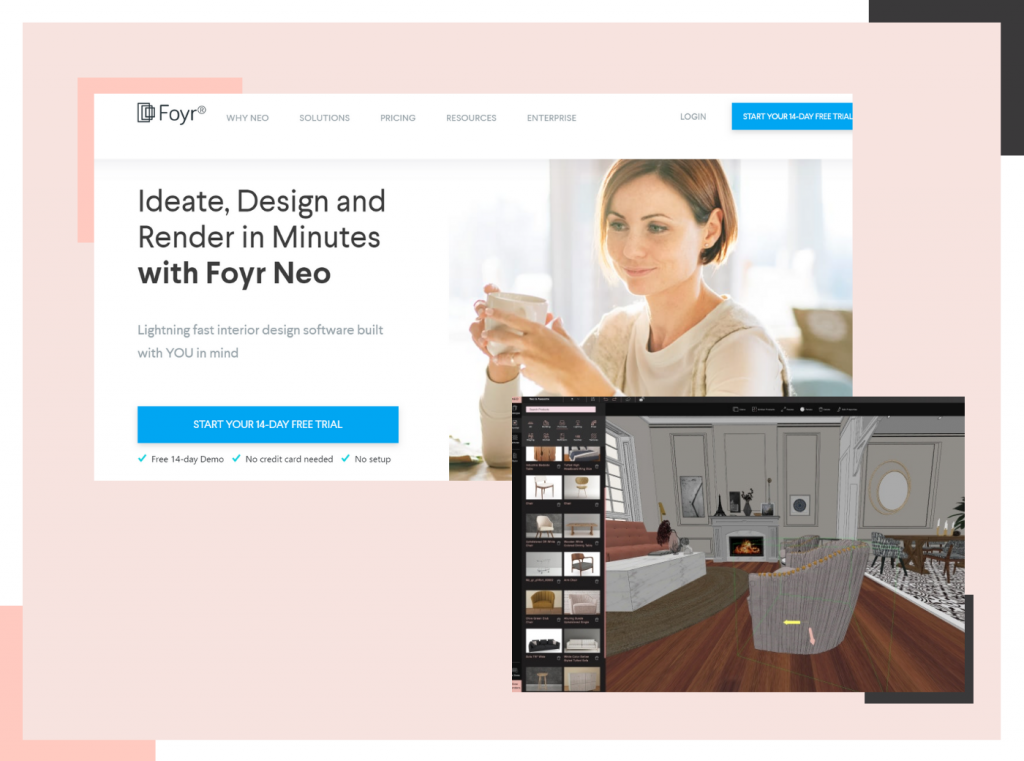Table of Contents
Interior design is a fusion of creative and technical aspects of transforming a space to a functional space with great aesthetics. Right from minimalist design ideas to using lighting for interior decorating, there are many ways in which interior design can impact your home decor.
However, what makes it challenging for beginners and customers while decorating their homes is an understanding of terms and jargon in interior design. This article will explain some key terminologies related to interior design.
But first, let’s understand the importance of understanding terms and jargons in interior design.
The Significance of Mastering Interior Design Terminology
Interior designers must master their craft to communicate effectively. Knowing design terms like focal point, negative space, and color temperature helps.
Some of the benefits of knowing the terms and jargon in interior design are,
- Enhanced communications – Critical interior design jargon is essential, especially when collaborating with other designers.
- DIY projects –If you enjoy doing home improvement projects independently, learning interior design terminology can be helpful. It will help you follow instructions and apply design principles properly for a desirable result.
- Personalization- Using specific words like ‘bespoke’ can help you make things exactly how you want them. When you know how to explain what you want, it’s easier to get things that make you happy and make your home look special.
- Confidence in Style Choices- When it comes to design, words like ‘Eclectic’ and ‘Elevated’ can help you understand specific styles. Knowing these terms can help you discover what you like and encourage you to try new things.
- Saves time- Knowing these terms can make decision-making and carry out tasks quicker because less time is spent explaining what they mean.
Color and Texture Terminology
Choosing colors for a room can make a big difference. Consider the color wheel, textures, and your audience’s preferences. Create a pleasing, attractive design that feels welcoming.
Here are some key color and texture terminologies that you should know:
#1. Color Wheel
A color wheel is a fundamental tool that organizes colors in a circular arrangement, helping designers comprehend their relationships and interactions. It consists of primary colors (red, blue, and yellow), secondary colors (green, orange, and purple), and tertiary colors, achieved by mixing primary and secondary colors.
This tool aids in selecting harmonious color schemes and understanding the balance between contrasting and complementary hues.
#2. Complementary Colors
Complementary colors are pairs of colors positioned opposite each other on the color wheel. When placed together, these combinations create a striking contrast, making each color appear more vibrant.
Using complementary colors in interior design can bring dynamism and energy to a space. For instance, pairing red and green or blue and orange can create a stimulating visual impact.
#3. Monochromatic
A monochromatic color scheme uses varying shades, tones, and tints of a single color. This approach creates a sense of harmony and unity within a space while allowing for subtle variations in color intensity.
Monochromatic designs can be sophisticated and soothing, potentially evoking specific moods based on the chosen color.
#4. Contrast Texture
The contrast in texture involves using different textures to create visual diversity. For example, pairing a rough, textured wall with smooth, glossy furniture can create a pleasing contrast that draws attention.
Understanding the Impact of Color Schemes and Textures on Design Aesthetics
Color and texture affect a room’s look, feel, and mood. Light colors make a room feel larger, dark colors make it feel smaller. Warm colors create a cozy atmosphere, cool colors create a calming space. Smooth surfaces feel open and airy, rough surfaces feel cozy. Consider the overall effect you want to create when choosing colors and textures.
Elements of Space and Layout Jargon
Understanding focal point, negative space, and visual weight helps designers create engaging, balanced designs that evoke emotions and connect elements.
#5. Focal Point
A focal point is an eye-catching element in a room that anchors the design and guides the viewer’s gaze. It can be a piece of furniture, art, or an architectural feature.
#6. Negative Space
Negative space, or white space, is the area around design elements. It helps other elements stand out and creates balance, clarity, and elegance.
#7. Visual Weight
Visual weight determines how important an element looks in a design. It’s affected by size, color, texture, and placement. Heavy elements stand out, light elements recede. Balance ensures no element overpowers the others.
Read also – How To Use Positive and Negative Space in Interior Design?
Influence on Spatial Arrangement and Visual Balance
When designing a space, consider the focal point, negative space, and visual weight. These elements create balance, contrast, and harmony. By distributing visual weight evenly, you can achieve a sense of symmetry and stability, resulting in a pleasing and cohesive arrangement.
Furniture and Accessories Vocabulary
Interior design terms for furniture and accessories are essential to understand because they can help you communicate decorating style with designers. Another critical advantage is decision-making.
#8. Chaise Lounge
A chaise lounge is a comfortable and stylish seat for reclining. It is the English version of the “chaise longue,” a popular French piece of furniture with a backrest and armrest on one side.
#9. Occasional Table
Occasional tables are versatile furniture that add style and function to any room. They come in a variety of shapes and sizes to suit your needs.
#10. Mullions
Mullions are vertical or horizontal dividers in windows and doors that support and stabilize the frame, and add visual interest.
Read also – 10 Furniture Styles & Trends That You Can’t Afford to Miss in 2023
Understanding the roles and types of furniture and accessories in design
Furniture and accessories play a crucial role in interior design, affecting a space’s style, atmosphere, and functionality. They contribute to a room’s visual appeal and allow individuals to showcase their tastes. Careful selection and arrangement can create a functional and aesthetically pleasing space.
Lighting and Illumination Language
Lighting is crucial for interior design and architecture. It affects the appearance and functionality of a space. Knowing lighting terminology is essential to create an optimal lighting plan.
#11. Lumens
Lumens measure brightness, quantifying the amount of visible light emitted by a light source. Consider brightness when choosing lighting. Lumens measure visible light emitted, while watts measure energy. Higher lumens for task areas, lower for cozy ambiance.
#12. Color Temperature
Color temperature refers to the color appearance of light, which is measured in Kelvin (K). Consider color temperature when choosing lighting. Warmer tones (2700K-3000K) create a cozy atmosphere, while cooler tones (5000K-6500K) provide an energetic ambiance.
Choose color temperature based on the mood and purpose of the room. Warmer tones for living spaces, cooler for offices and task areas.
#13. Cove Lighting
Cove lighting is a design technique that uses indirect light to create a soft, elegant atmosphere. It can be used to accentuate architectural features and design elements.
Take an example of a chandelier, which provides an amazing impact on the aesthetics of interior walls.
Similarly, you can use American-style sconces for more impactful cove lighting or Asian-style lighting with high-end light bulbs which offer illumination close to natural light.
Cove lighting reduces harsh shadows and glare, adding elegance to the decor. It can accentuate architectural features, such as ceilings and walls.
Read also – 16 Best Interior Lighting Tips To Beat The Winter Blues
How design styles and movements influence aesthetics and choices?
Lighting is crucial in designing ambient space. The type, intensity, and placement of lights impact a room’s atmosphere. Soft, warm lighting is ideal for cozy areas like bedrooms, while bright, cool lighting is energizing and suitable for workspaces and kitchens. Task lighting helps with specific activities.
Textile and Fabric Jargon
In interior design, familiarizing yourself with terms and jargon is essential for effective communication and understanding. Let’s delve into some key textile and fabric terminologies:
#14. Bolster Pillow
A long, narrow pillow, often cylindrical, is used to provide support or decoration on beds, sofas, or other furniture. Bolster pillows can enhance both comfort and aesthetics in interior spaces.
#15.Velvet
A luxurious and soft fabric with a dense pile created through weaving techniques. Velvet adds texture, depth, and luxury to furniture and accessories, making it a favorite in elegant and lavish designs.
#16. Chenille
Named after the French word for caterpillar, Chenille is a fabric with a fuzzy texture created by weaving short lengths of yarn between two core yarns. Chenille fabrics are used in upholstery and soft furnishings due to their softness and durability. It can be made from a variety of fabrics including cotton, silk, wool, and rayon.
Read also – The Complete Guide To Use Textures in Interior Design
Architectural Features and Structural Terminology
In the realm of interior design, architectural features, and structural terminology play a pivotal role in shaping the character of spaces.
Let’s explore some essential terms:
#17. Soffit
The underside of a structural element, such as a beam or arch, extends from a wall to the outer edge of a roof. Soffits often conceal mechanical systems and provide a smooth transition between walls and ceilings.
#18. Crown Molding
Decorative molding is installed where walls meet the ceiling, adding elegance and detail to a space. Crown molding can visually elevate the height of a room and bring a touch of sophistication. It is a modern design style defining the intersection of ceiling and interior walls.
#19. Transom
A horizontal window situated above a door or larger window allows additional light to enter and enhances architectural interest. Transoms can be functional or purely decorative elements that you can complement with a retro-style window covering
#20. Nautical
In Florida homes with coastal elements, the nautical look is common. Seashells and lighthouse decor adorn coffee tables and walls, creating a light and breezy atmosphere. Complementary accent colors and window treatments feature sheer shades of navy blue, white, and gold.
Wall Covering and Flooring Terms
Interior design encompasses a plethora of choices, including wall coverings and flooring options.
Let’s decode some key terms:
#21. Wainscoting
Decorative paneling is applied to the lower portion of a wall, often topped with a chair rail. Wainscoting adds texture and visual interest to walls, and it can also protect them from wear and tear.
#22. Terrazzo
A composite material consisting of chips of marble, quartz, granite, or glass is set in a binder, then polished to create a smooth surface. Terrazzo is used for flooring, countertops, and other surfaces, adding a touch of artistic flair.
#23. Vinyl Plank
A type of flooring made from vinyl that resembles the appearance of hardwood planks. Vinyl plank flooring is durable, easy to maintain, and has various styles and finishes.
Understanding the variety of wall coverings and flooring options empowers interior designers to select materials that align with their design vision and clients’ preferences.
Read also – 20 Decorative Wall Paneling Ideas for Your Room
Styles and Movements Language
Interior design is heavily influenced by various styles and movements.
Let’s explore some key terms:
#24. Art Deco
An influential design style from the 1920s and 1930s characterized by geometric shapes, bold colors, and luxurious materials. Art Deco brings a sense of glamor and opulence to interiors by adding ornamentations, geometric patterns and motifs.
#25. Mid-century Modern
Mid-century modern design is simple, functional, and timeless. It features clean lines, organic and geometric shapes, and simple furniture with minimal elaboration. Coffee tables and chairs are particularly beautiful pieces.
#26. Bohemian
A style characterized by a relaxed, eclectic, and colorful approach. Bohemian interiors often incorporate vibrant textiles, global-inspired patterns, and a mix of cultural influences.
#27. Feng shui
Feng Shui is an ancient Chinese practice that arranges spaces and objects to harmonize energy flow and enhance well-being. It uses guidelines such as the Five Elements and the Bagua map to create environments with positive energy.
Sustainability and Green Design Jargon
With the growing emphasis on sustainable practices, interior designers need to understand eco-conscious terminology. Let’s explore key terms:
#28. LEED Certification
Leadership in Energy and Environmental Design (LEED) certification signifies that a building or interior space meets stringent sustainability standards, from energy efficiency to material selection.
#29. Carbon Footprint
The total amount of greenhouse gas emissions produced directly or indirectly by an individual, organization, or product. Minimizing carbon footprints is crucial for environmentally responsible design.
#30. Upcycling
Upcycling is reusing materials to create new products of higher value. It reduces waste and promotes resourcefulness. Interior designers should understand sustainability terms to create environmentally conscious spaces.
Reas also – Green Living: 10 Ways to Turn Your Home from Toxic to Eco-friendly
Foyr Neo: Visualizing Interior Design Concepts
Foyr Neo for visualizing design concepts makes it easier for you to learn and use design terms. Itis an interactive tool that helps both beginners and professionals improve their design skills.
You can experiment with virtual design elements and instantly see how they impact a space. Foyr Neo turns abstract ideas into 3D models and realistic images, allowing you to understand spatial relationships and proportions.
Its rendering capabilities are exceptional, and you can experiment with different materials, textures, lighting, and color schemes to create visually appealing interiors.
Conclusion
Understanding the terms and jargon in interior design is crucial for design professionals and customers. It enhances communication and improves understanding of how different interior design styles impact a space layout. Further, it also helps decide what color palettes, laminates, and decor will suit your home decor.










